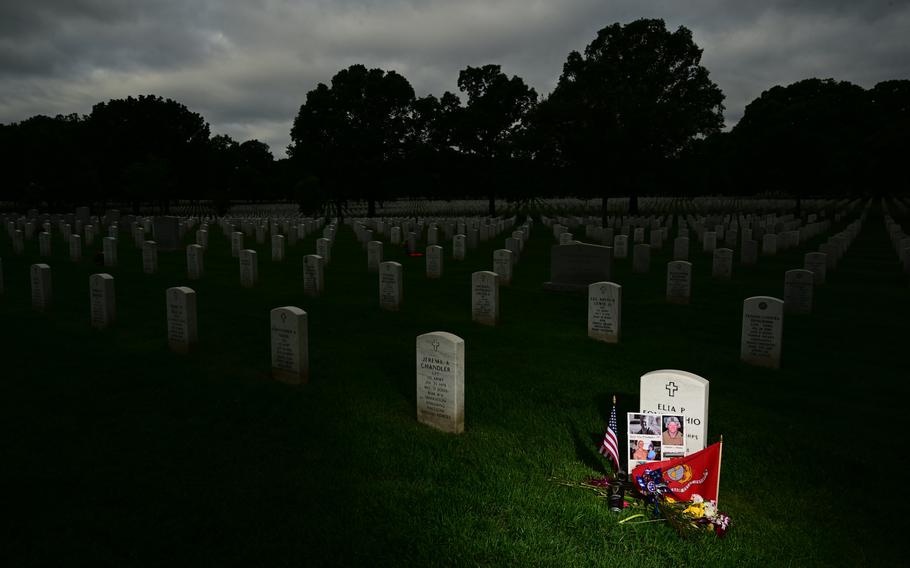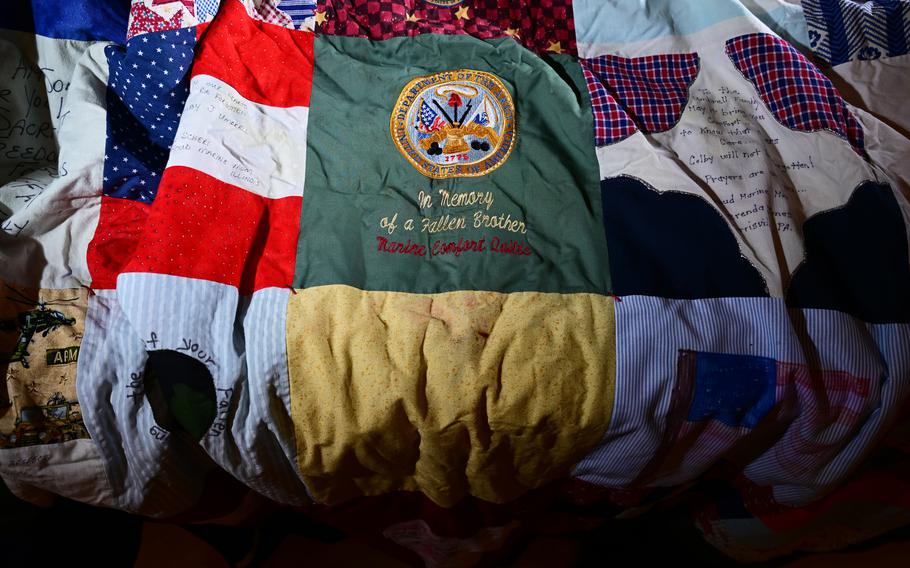
Items left at a grave in Arlington National Cemetery’s Section 60, where those who died in America’s post-9/11 wars are buried. MUST CREDIT: Matt McClain/The Washington Post (Matt McClain)
During one of their winter visits to Arlington National Cemetery, Mark and Nancy Umbrell placed a colorful patchwork quilt beside their son Colby’s grave. It had arrived in the mail years earlier from a sender they did not know after the 26-year-old’s 2007 death in Iraq.
They had observed other visitors leaving mementos, a gesture that felt to them like a fitting way to both honor the fallen Army officer and thank the quilt maker whose kindness meant so much in their moment of grief, Nancy Umbrell said.
Days later, Rod Gainer set out on his weekly walk through Section 60, the cemetery’s 14-acre parcel where Colby Umbrell and other U.S. service members lost to the wars in Iraq and Afghanistan and counterterrorism missions elsewhere. As Gainer, the cemetery’s historical curator, surveyed the thousands of snow-dusted headstones, he spotted the quilt and approached, gently tucking it under his arm while tagging it with the plot number and date, Feb. 2, 2019.
Today, the Umbrells’ quilt belongs to a collection of more than 3,250 keepsakes gathered over the past 15 years from Section 60. Each is packed in a transparent red plastic bag, placed inside a white corrugated cardboard box, like the kind that holds printer paper, and locked out of sight in a climate-controlled underground corridor not far from the Tomb of the Unknowns.
Among them is a wooden plaque bearing the names of two Marines killed in 2005. A diamond cross necklace. There are letters, photographs, patches and pins. A high school football helmet. Even an old Nintendo Game Boy.
“It’s an amazing slice of life in the early 21st century of America,” Gainer said, adding that it humanizes the cost of these conflicts.
Yet Arlington Cemetery, in the midst of an expansion to accommodate tens of thousands of future burials, has no plan for the long-term storage of Section 60 mementos, and it lacks the space and budget to properly conserve and display them, Gainer said. He said that because the boxed archives are not official U.S. government property, they are ineligible for taxpayer funding.
Instead, Gainer said, he wants the Army, which oversees the cemetery, to have the objects appraised and then pay an outside organization to take possession of and curate them in a manner befitting their historical significance. To date, no candidates have been identified, leaving these artifacts to languish — out of sight and out of mind.
“We’d like to get it conserved,” Gainer said of the collection. “We would also like to park it somewhere, with an institution that would appreciate it and take good care of it.”
At the height of the wars in Iraq and Afghanistan, families and friends visiting those interred in Section 60 began adorning the white marble headstones to mark birthdays and anniversaries or otherwise pay tribute to their lost loved ones. In 2009, the Army Secretary, Pete Geren, asked the cemetery’s museum staff to hold on to items possessing artistic or historical significance.
For the next decade, once collected they were transferred to Fort Belvoir, an Army post in D.C.’s Virginia suburbs about 20 miles south of the cemetery. About four years ago, Gainer and his team retrieved what he calls the “core collection.” They brought the items back to Arlington to be inventoried with the aim of one day handing them over to another caretaker.
Inside a chapel adjoining the storage area, Gainer unfurled Colby Umbrell’s quilt on a pale slab of Vermont marble. The collection includes at least one memento for every service member interred in Section 60 who died as a result of America’s post-9/11 conflicts, Gainer said, with a small number having been displayed here.
Not every memento that is collected gets marked for preservation, he said. Many are too damaged by the elements or mold while others just don’t have much historical import. Those items, stored at Fort Belvoir, will be disposed of, eventually.
The Army sought to shutter the program in 2014, but items kept appearing — and the cemetery staff has continued to retrieve and catalogue them. There aren’t as many these days, though. The COVIS-19 pandemic forced a lull in visits to Section 60 that, for now, seems to have stuck.
Recalling the frigid winter mornings when the Umbrells of Ocean City, Md., would visit their son’s grave, Mark Umbrell noted how in years past, “there was never a time somebody wasn’t in Section 60.” He paused. “It’s is becoming lonelier now.”
Arlington Cemetery’s dilemma over how to permanently care for these objects bears a striking similarity to that faced by the National Park Service starting in the early 1980s, when the Vietnam Veterans Memorial opened on the National Mall and “offerings” began to appear at the site, the agency wrote in a report published in 2021.
In 1984, a decision was made to preserve them. The full collection, which now numbers in the hundreds of thousands, was moved to the National Capital Area’s Museum Resource Center in Landover, Md., where it remains. It is not available for public viewing, though some items can be seen online and sometimes they are shared with museums like the Smithsonian. “The Wall That Heals,” a mobile exhibit, also includes some replicas of mementos.
Janet Folkerts, who oversaw the curation effort for many years, said that for long-term preservation, “you’re really trying to mitigate what we call the agents of deterioration,” such as humidity, light and pests drawn to organic materials like wood and certain fabrics. The keepsakes stored at Arlington Cemetery may be fine for now, she said, but “once you’ve decided that you’re making a commitment to care for those objects, putting them into an environment where they’re safe, and all of those agents are mitigated, it is really the best choice.”

The quilt left at the grave of Army 1st Lt. Colby J. Umbrell. (Matt McClain/The Washington Post)
The “comfort quilt” Nancy and Mark Umbrell received in the mail is one of an estimated 3,000 that Spring Valley, Ill., resident Susan Scheri said she helped craft over 10 years. She recalled that when she made Colby Umbrell’s quilt in 2007, the war in Iraq dominated the news cycle.
A network of military families made and often scrawled messages on individual quilt squares for Scheri to sew together and then ship to grieving families. She joined the quilting group to help her endure the stress of having her own son serving abroad as a Marine, she said.
“I would lay awake at night, and I’d hear a car pulling into our subdivision and stop,” Scheri said. “I would hold my breath and wait for my golden retriever to go to the door and bark, or to stay in the bedroom. That’s a hard thing for a mother to do.”
The quilt “was a beautiful thing to receive,” Nancy Umbrell said. People often avoid mentioning their son for fear of upsetting her, she said. But it makes her feel good when people want to remember Colby and talk about him.
“Ninety-nine point nine percent of Gold Star parents,” she said, “would say the same thing.”
The Umbrells said they did not know what would happen to their son’s quilt when they left it at Arlington Cemetery. Asked about the cemetery’s desire to properly archive the Section 60 mementos, Nancy Umbrell acknowledged harboring some concern about the cost to taxpayers but said that if funding were no issue, then “in a perfect world, I would want everybody to see them.”